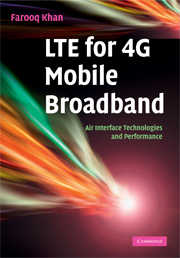Refine search
Actions for selected content:
1983 results in Distributed, Networked and Mobile Computing
Contributors
-
- Book:
- Emerging Wireless Technologies and the Future Mobile Internet
- Published online:
- 03 May 2011
- Print publication:
- 07 March 2011, pp ix-x
-
- Chapter
- Export citation
4 - Opportunistic Delivery Services and Delay-Tolerant Networks
-
-
- Book:
- Emerging Wireless Technologies and the Future Mobile Internet
- Published online:
- 03 May 2011
- Print publication:
- 07 March 2011, pp 92-124
-
- Chapter
- Export citation
Foreword by Hisashi Kobayashi
-
-
- Book:
- Emerging Wireless Technologies and the Future Mobile Internet
- Published online:
- 03 May 2011
- Print publication:
- 07 March 2011, pp xi-xii
-
- Chapter
- Export citation
9 - Opening Up the Last Frontiers for Securing the Future Wireless Internet
-
-
- Book:
- Emerging Wireless Technologies and the Future Mobile Internet
- Published online:
- 03 May 2011
- Print publication:
- 07 March 2011, pp 242-282
-
- Chapter
- Export citation
1 - Introduction
-
-
- Book:
- Emerging Wireless Technologies and the Future Mobile Internet
- Published online:
- 03 May 2011
- Print publication:
- 07 March 2011, pp 1-18
-
- Chapter
- Export citation
2 - Next-Generation Wireless Standards and Their Integration with the Internet
-
-
- Book:
- Emerging Wireless Technologies and the Future Mobile Internet
- Published online:
- 03 May 2011
- Print publication:
- 07 March 2011, pp 19-53
-
- Chapter
- Export citation
Contents
-
- Book:
- Emerging Wireless Technologies and the Future Mobile Internet
- Published online:
- 03 May 2011
- Print publication:
- 07 March 2011, pp v-viii
-
- Chapter
- Export citation
10 - Experimental Systems for Next-Generation Wireless Networking
-
-
- Book:
- Emerging Wireless Technologies and the Future Mobile Internet
- Published online:
- 03 May 2011
- Print publication:
- 07 March 2011, pp 283-311
-
- Chapter
- Export citation
6 - Network Services for Mobile Participatory Sensing
-
-
- Book:
- Emerging Wireless Technologies and the Future Mobile Internet
- Published online:
- 03 May 2011
- Print publication:
- 07 March 2011, pp 154-177
-
- Chapter
- Export citation
5 - Sensor Networks Architectures and Protocols
-
-
- Book:
- Emerging Wireless Technologies and the Future Mobile Internet
- Published online:
- 03 May 2011
- Print publication:
- 07 March 2011, pp 125-153
-
- Chapter
- Export citation

LTE for 4G Mobile Broadband
- Air Interface Technologies and Performance
-
- Published online:
- 28 February 2011
- Print publication:
- 26 March 2009
Part III - Protocols and practice
-
- Book:
- Next-Generation Internet
- Published online:
- 05 October 2012
- Print publication:
- 03 February 2011, pp 217-218
-
- Chapter
- Export citation
6 - Host identity protocol (HIP): an overview
- from Part II - Network architectures
-
-
- Book:
- Next-Generation Internet
- Published online:
- 05 October 2012
- Print publication:
- 03 February 2011, pp 107-135
-
- Chapter
- Export citation
18 - Network economics: neutrality, competition, and service differentiation
- from Part IV - Theory and models
-
-
- Book:
- Next-Generation Internet
- Published online:
- 05 October 2012
- Print publication:
- 03 February 2011, pp 378-402
-
- Chapter
- Export citation
7 - Contract-switching for managing inter-domain dynamics
- from Part II - Network architectures
-
-
- Book:
- Next-Generation Internet
- Published online:
- 05 October 2012
- Print publication:
- 03 February 2011, pp 136-153
-
- Chapter
- Export citation
10 - Architectural support for continuing Internet evolution and innovation
- from Part II - Network architectures
-
-
- Book:
- Next-Generation Internet
- Published online:
- 05 October 2012
- Print publication:
- 03 February 2011, pp 197-216
-
- Chapter
- Export citation
1 - Optical switching fabrics for terabit packet switches
- from Part I - Enabling technologies
-
-
- Book:
- Next-Generation Internet
- Published online:
- 05 October 2012
- Print publication:
- 03 February 2011, pp 3-26
-
- Chapter
- Export citation
Part II - Network architectures
-
- Book:
- Next-Generation Internet
- Published online:
- 05 October 2012
- Print publication:
- 03 February 2011, pp 105-106
-
- Chapter
- Export citation
17 - Network coding in bi-directed and peer-to-peer networks
- from Part IV - Theory and models
-
-
- Book:
- Next-Generation Internet
- Published online:
- 05 October 2012
- Print publication:
- 03 February 2011, pp 359-377
-
- Chapter
- Export citation
Part I - Enabling technologies
-
- Book:
- Next-Generation Internet
- Published online:
- 05 October 2012
- Print publication:
- 03 February 2011, pp 1-2
-
- Chapter
- Export citation
